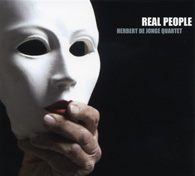
Herbert De Jonge Quartet
Real People
(EWM)
An album that I happened to find inside my mailbox, in the end Real People
revealed itself as a very nice surprise; it was only after repeated listening
sessions, though, after I proceeded to reset a few erroneous expectations
that, as it sometimes happens, I had unconsciously developed, that I really
came to appreciate it.
And
this is the reason why (the short version, anyway): looking at the list
of the featured players, alongside names that to me were totally unknown,
such as those of Charles Huffstadt (drums), Esmee Olthuis (alto and soprano
saxophones), and Herbert De Jonge (piano and composition), I saw the only
name I was familiar with: double bass player Arjen Gorter, whom I had known
for quite a long time especially for his being a long-standing member of
Willem Breuker’s Kollektief. And then I thought about a keyboard player
in Breuker’s line-ups, Henk De Jonge.
In
a nutshell, the music that’s featured on this CD is easily definable as
being
"classic jazz", if not quite "almost mainstream". But
here we have to keep in mind that it’s the "classic jazz" definition
that takes into account the passing of time: nowadays a theme doesn’t necessarily
have to appear at the start of a track; solos are not forced to follow a
chord map; and, if so desired, instruments can easily switch roles.
This
is not, let’s make this immediately clear, "abrasive music";
and were I to offer some useful coordinates to the listener – al least,
one always hopes they are useful – I’d mention Paul Bley, not Cecil Taylor
(not even end-of-the-Fifties Taylor). To back my impression, at least when
it comes to Real People’s first four tracks, I’d show those thoughtful
silences on the piano, Gorter’s "fat" timbre on his instrument,
and a very "light"
drum-set, where cymbals are often used in a melodic way, and as colour; it’s
only logical that listeners’ thoughts will go to the Gary Peacock-Paul Motian
rhythm section. After (what I perceive to be) a kind of closure of track
#5, the album appears to change its direction, with an effect that’s not
bad at all, and the coming to the fore of a few surprising elements.
Before
saying something about the individual tracks, I’ll anticipate my conclusions:
Those who only like "abrasive" will regard the general framework
of this album as being a bit too "old-fashioned", I’m afraid.
I think that Real People’s best listeners will be those who cultivate careful
listening as a way to reveal a discreet kind of quality. It’s not a
"masterpiece", but this album deserves more than the sad destiny
from the lack of promotion that an indie label like this can afford.
Balacarde
is a nice start for the album, with its melodic theme and a thoughtful
alto sax; then we have piano, double bass, cymbals; a nice piano solo,
then an alto sax solo (all over the album Esmee Olthuis often plays the
alto as a light and airy lower version of the soprano). Theme, end.
Wit
En Blauw starts with a very Bley-like piano, in trio, in a medium tempo,
and a nice unison of double bass and De Jonge’s left hand, working as a
counterpoint to his right hand ostinato (and yes, I really would have liked
this unison to be more clearly recorded); an airy theme for soprano sax,
the kind that sticks in one’s mind.
Mirjam
offers a light performance from the soprano, a Bley-like atmosphere, cymbals
à la Motian, and a very nice snare drum with a resonant snare.
Happy
moves a lot more, with a two-handed, "classic" piano performance,
a
"semi-free" quartet, and the alto sax to the fore. Strong
"swing-blues" move from the double bass. An extroverted track.
Voor
Wie Dit Geldt is quite still, with piano and a "whispering" alto.
Not the album’s best moment, in my opinion, but a track that appears to
divide the album in "two parts".
Madre
DD starts with solo soprano sax, it then blooms in a slow theme. Strange
as it may seem, to me the soprano sounded almost like a transposition of
Elton Dean’s saxello.
A
"muscular" drum set, the soprano sax, an "orthodox" piano
solo are featured on Witch Way. Here, too, I seemed to detect Elton Dean’s
presence, but it’s the track as a whole that to me sounds like an
"acoustic transposition" of some atmospheres appearing on Soft
Machine’s Fifth.
Vogeloog
it’s a ballad that sometimes seemed to quote from Ornette’s Lonely Woman.
Nice piano and alto sax solos.
A
"classic" development for Blue Moment, with a nice alto sax-piano
unison, a "walking" double bass, and nice piano and alto sax solos.
Gods
Noorwegen is the fine album closer: "ballad-style" piano intro,
trio, excellent double bass solo, nice soprano sax solo, then the piano
brings the piece to its close.
Beppe Colli
© Beppe Colli 2008
CloudsandClocks.net | Mar. 25, 2008


